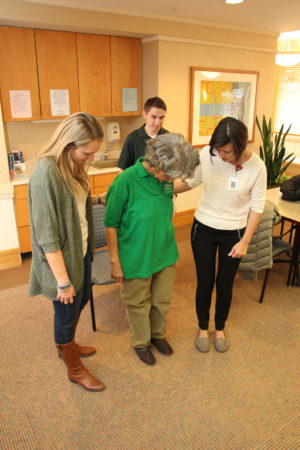
The Participation, Environment and Performance Laboratory has developed assessment and intervention training for occupational therapists practicing in the home. These programs are targeted to support aging in place for older adults. Populations include older adults living in the community, transitioning home after stroke, or who are at risk for falls, as well as caregivers. Additional information can be found on the individual pages.
Training Available
HARP: Home Hazard Removal Program
HARP is a tailored home hazard removal program to reduce fall risks in the homes of older adults. HARP is delivered by an occupational therapist over two to three visits, with a booster visit at 6 months. Together, the therapist and the older adult identify potential fall hazards (e.g., inadequate lighting, clutter, loose rugs) and develop a plan to address them. The therapist then carries out the plan, installing minor modifications and engaging a contractor if needed.
I-HOPE: In-Home Occupational Performance Evaluation
The I-HOPE is an assessment targeting activities performed in the home that are essential for aging in place. An occupational therapist works with the older adult to comprehensively evaluate the individual’s performance of 44 activities in the home, including the older adult’s satisfaction with their performance, and identifying barriers to performance.
COMPASS: Community Participation After Stroke
COMPASS is a program designed to reduce barriers to independent living for individuals returning home after experiencing a stroke. COMPASS is delivered by an occupational therapist; it consists of one visit prior to discharge from the hospital/rehabilitation center and five home visits. The therapist assesses the individual’s home and develops a tailored plan to remove barriers to independent living.
Fall Prevention Bingo
Fall Prevention Bingo is an activity designed to provide fall prevention information in a fun and engaging format. Anyone can play Fall Prevention Bingo, which is played like traditional bingo, except the bingo numbers have been replaced with evidence-based fall prevention information. We have played Fall Prevention Bingo with older adults in senior centers, apartment buildings and naturally occurring retirement communities, and we also have a version that can be played at home with family and friends.
If you have any questions about our training, please contact us at peplab@wustl.edu.
Fall Prevention Resources
If you or a loved one has had a fall or is worried about falling:
1. Work with your primary care physician or geriatrician to discover the reason for the fall. Falls often have multiple causes—effective fall prevention means understanding the risk factors faced by you or your loved one and addressing those risk factors. You can find more information about this from the CDC.
2. Contact us at peplab@wustl.edu to receive a Home Safety Self Assessment Tool (HSSAT) packet. It includes information about home hazards as well as fall prevention resources like those from OASIS.